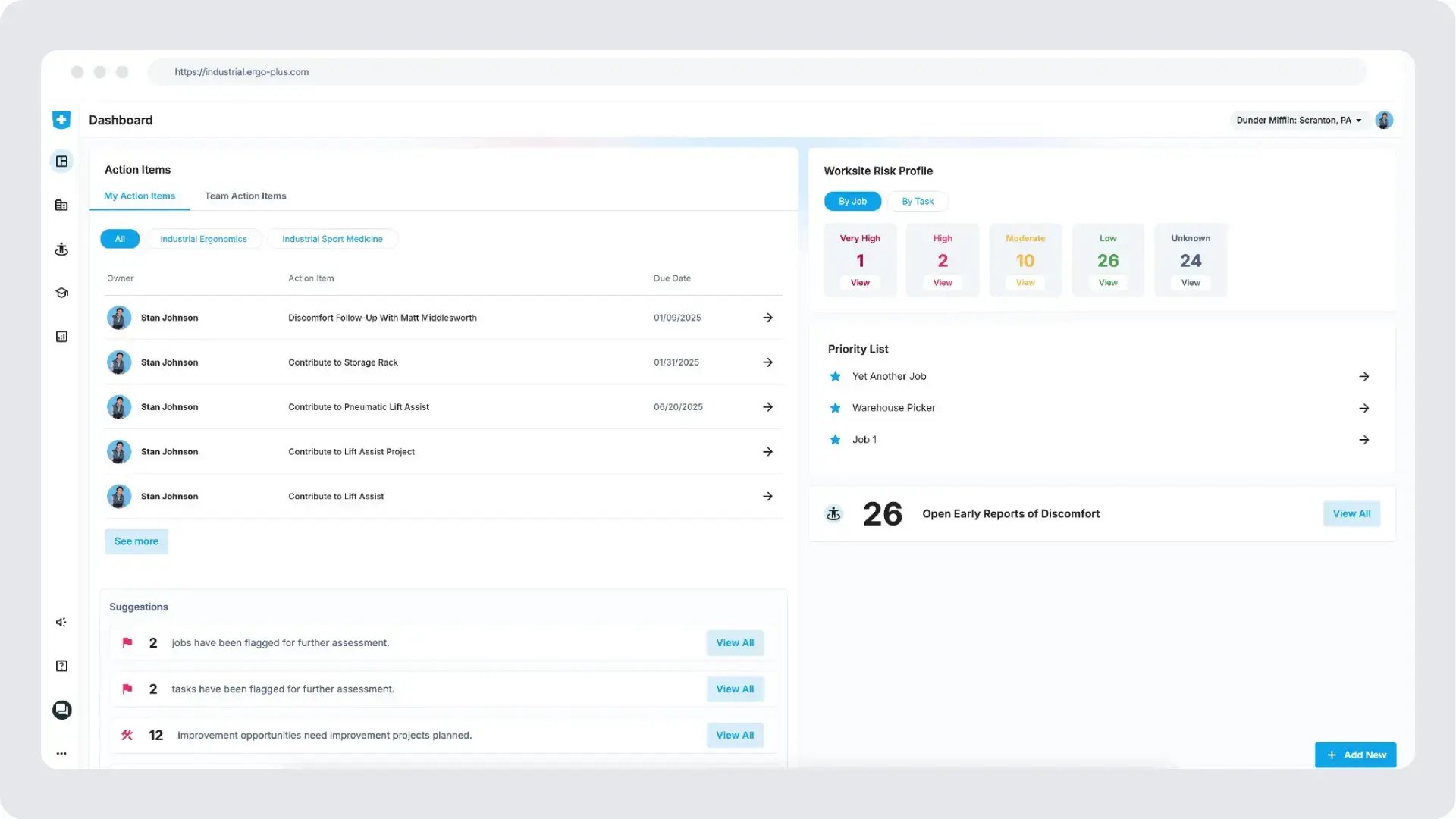The workplace landscape is evolving rapidly, driven by advancements in technology, changing employee expectations, and a renewed focus on health and safety. With a low unemployment rate and the rise of hybrid work models, organizations face unique challenges in retaining talent and ensuring employee well-being. The integration of artificial intelligence and automation into ergonomic practices presents both opportunities and complexities that must be addressed.
Your Guide to Ergonomic Trends in 2025
In this dynamic environment, staying informed about the latest trends in ergonomics is essential for fostering a culture that prioritizes worker health and productivity. From innovative office equipment to proactive risk assessments, understanding these shifts will empower organizations to create safer, more efficient workspaces. Join us as we explore the key trends shaping ergonomics in 2025 and the vital role they play in enhancing employee satisfaction and operational success.
Trend #1: The Impact of Artificial Intelligence (AI) in Ergonomics
The integration of AI tools into the work environment and ergonomic systems is already beginning and practically unavoidable. These technological innovations are often beneficial, but a trained ergonomist is still needed to interpret the data and implement actual change.
- Adoption Rates: A recent report from Section indicated that 18% of companies have fully embraced AI, while 45% have allowed its use without specific guidelines, 26% remain neutral, and 11% have explicitly banned or not allowed AI use. Of those companies that have explicitly banned AI usage, over 40% of employees reported still using these tools.
AI can be seen in everyday ergonomics with tools like video capture and data analysis. Major concerns from ergonomists in the workplace today are that while this data is captured constantly, many companies don’t know what to do with it. Avoiding this analysis paralysis is key to long-term success.
- Safety and Policy Considerations: The need for clear organizational policies regarding AI usage was stressed, as its integration raises questions about safety and employee engagement.
Trend #2: Low Unemployment Rate and Its Implications
With the unemployment rate currently at 4.1%, employers must understand that workers’ choice of work is growing. Creating a workplace that emphasizes safety has shown to increase retention, attracting talent and keeping experienced employees at your company.

Trend #3: OSHA Requirements and Compliance
- Ergonomics is Included Under OSHA General Duty Clause: Employers are required to provide a safe working environment that is free from hazards, which includes ergonomic hazards.
- Case Study: A notable settlement between OSHA and Amazon reached at the end of 2024 underscores the importance of ergonomics for both workforce health and OSHA compliance. In the settlement, Amazon committed to conducting annual ergonomic risk assessments and having a Site Ergonomic Lead (SEL) in their facilities.
Trend #4: The Shift to Hybrid Work Models
The transition to hybrid work arrangements has reshaped workplace ergonomics from the ground up. Considerations for non-conventional workplaces, virtual consultations, and addressing workers on the go are all vital parts of new programs:
- Home Office Improvements: Many employees have upgraded their home office setups, moving away from temporary solutions that may have caused discomfort during the pandemic. Companies can support their remote and hybrid workers by providing access to ergonomic furniture and office ergonomic assessments.
- Office Environment Considerations: There is a “return to office” trend in 2025 as many large organizations are requiring employees to return to the office in a full or part-time capacity. To support this change, ergonomists must ensure that in-office setups are conducive to worker health and productivity.
- Remote Monitoring: Employers are now able to connect with workers across the city, continent, or globe. Remote ergo assessments can help resolve problems for employees from anywhere at any time, and wearable sensors can provide data points from the field with ease..
Technological Advancements in Ergonomics
Technological advancements are playing a transformative role in ergonomics, significantly enhancing workplace safety and efficiency. Tools such as video capture technology enable real-time analysis of ergonomic risks, providing visual evidence that can inform necessary adjustments. Wearable sensors monitor workers' health metrics, helping to track fatigue levels, posture, and movement throughout the day. Many employees already wear sensors in the form of their smart devices as well.
Additionally, the introduction of exoskeletons offers physical support for employees engaged in heavy lifting or repetitive tasks, potentially reducing the risk of musculoskeletal disorders. Deep dive ergonomic assessments and task analysis, along with proper selection and implementation of the exoskeletons directly affect the effectiveness. The exact role of exoskeletons is still hotly debated, whether as PPE, lifting aids, or other specifications.
By integrating these innovative technologies, organizations can create a more responsive and proactive approach to ergonomic challenges, ultimately fostering a healthier and more productive work environment.
Robotics and Automation
The integration of robotics into ergonomic solutions is also gaining traction:
- Reducing Physical Strain: Automated systems can help mitigate workplace risks while enhancing productivity.
- Holistic Approach: It’s essential to view robotics as part of a broader safety strategy rather than a standalone solution.
Evolving Office Ergonomic Equipment
The importance of movement on combatting sedentary lifestyles is essential. Some ergonomists are beginning to consider new strategies to address this in the workplace:
- Movement as a Mitigation Strategy: Encouraging employees to move at least once an hour is crucial in combating musculoskeletal disorders. Some office ergonomics software can prompt workers to get up and stretch or employees can incorporate reminders or alarms into their days.
- Innovative Equipment: New office equipment, such as walking pads and sit-stand desks, are becoming more accessible and affordable. However, safety concerns must be addressed, and proper footwear is essential to prevent injuries.
- Ergonomic Accessories: The introduction of various ergonomic tools, like split keyboards and contour mice, reflects the evolution of office equipment. These tools can enhance comfort and reduce strain when used correctly.
Engagement and Program Continuity
Despite advancements in technology and equipment, the core goals of ergonomic programs remain unchanged:
- Stakeholder Engagement: Continuous engagement from all levels of the organization is necessary for effective ergonomic initiatives. Support for safety teams and HR is crucial to reduce resource constraints and achieve the best possible return on investment.
- Proactive Risk Assessment: Companies must focus on proactively identifying hazards through risk assessment rather than simply analyzing injury rates to identify ergonomic problems. Briotix Health is experiencing a trend of increased engagement from companies investing in proactive on-site prevention activities and in-person training events.
Ergonomics Software Management Systems
Software management systems (like ErgoPlus Industrial, shown in the image below) are advancing every day to help manage ergonomics and safety in the workplace. Ultimately, these technologies help companies do more in less time.

- Program Tracking and Reporting: These platforms help safety teams with reporting and tracking on ergonomic program outcomes, growth, and overall program maturity.
- Standardize and Scale Improvements: By using a unified platform for ergonomics, companies can standardize their approach and scale solutions across one or many locations.
Understanding the evolving landscape of ergonomics and leveraging the latest tools and strategies will be crucial for fostering healthier workplaces. By addressing both technological advancements and foundational ergonomic principles, organizations can achieve sustainable and impactful ergonomics programs that prioritize employee well-being and productivity.
Briotix Health Certified Professional Ergonomists, Kristianne Egbert and Heather Ritz, recently presented a webinar on ergonomic trends and major shifts to watch for in 2025. The two CPEs provided valuable insights into the evolving landscape of ergonomics, particularly considering technological advancements and changing workplace dynamics. The discussion highlighted key trends that are currently shaping ergonomic practices and their implications for organizations and employees alike.
Looking to learn more about this conversation? Watch the full webinar here!